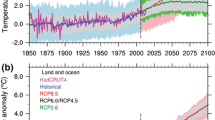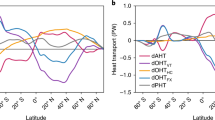Abstract
The entropy budget is calculated of the coupled atmosphere–ocean general circulation model HadCM3. Estimates of the different entropy sources and sinks of the climate system are obtained directly from the diabatic heating terms, and an approximate estimate of the planetary entropy production is also provided. The rate of material entropy production of the climate system is found to be ∼50 mW m−2 K−1, a value intermediate in the range 30–70 mW m−2 K−1 previously reported from different models. The largest part of this is due to sensible and latent heat transport (∼38 mW m−2 K−1). Another 13 mW m−2 K−1 is due to dissipation of kinetic energy in the atmosphere by friction and Reynolds stresses. Numerical entropy production in the atmosphere dynamical core is found to be about 0.7 mW m−2 K−1. The material entropy production within the ocean due to turbulent mixing is ∼1 mW m−2 K−1, a very small contribution to the material entropy production of the climate system. The rate of change of entropy of the model climate system is about 1 mW m−2 K−1 or less, which is comparable with the typical size of the fluctuations of the entropy sources due to interannual variability, and a more accurate closure of the budget than achieved by previous analyses. Results are similar for FAMOUS, which has a lower spatial resolution but similar formulation to HadCM3, while more substantial differences are found with respect to other models, suggesting that the formulation of the model has an important influence on the climate entropy budget. Since this is the first diagnosis of the entropy budget in a climate model of the type and complexity used for projection of twenty-first century climate change, it would be valuable if similar analyses were carried out for other such models.




Similar content being viewed by others
References
Arpe K, Brankovic C, Oriol E, Speth P (1986) Variability in time and space of energetics from a long series of atmospheric data produced by ECMWF. Beitraege zur Physik der Atmosphaere 59:321–355
Boville BA, Bretherton CS (2003) Heating and kinetic energy dissipation in the NCAR community atmosphere model. J Clim 16:3877–3887
Cox MD (1984) A primitive equation, three dimensional model of the ocean. GFDL ocean group technnical report no. 1, Princeton NJ, USA, 143 pp
Cullen M, Davies T (1991) A conservative split-explicit integration scheme with fourth order horizontal advection. Q J R Meteorol Soc 117:993–1002
Cullen M, Davies T, Mawson M (1993) Unified model documentation paper no. 10. Tech. rep., Meteorological Office, UK
DeGroot S, Mazur P (1984) Non-equilibrium thermodynamics. Kluwar, Dover
Edwards J, Slingo A (1996) Studies with a flexible new radiation code. Part I: Choosing a configuration for a large-scale model. Q J R Meteorol Soc 122:689–719
Egger J (1999) Numerical generation of entropies. Mon Weather Rev 127:2211–2216
Fraedrich K, Jansen H, Kirk E, Lunkeit F (2005) The planet simulator: towards a user friendly model. Meteorologische Zeitschrift 14:305–314
Fraedrich K, Lunkeit F (2008) Diagnosing the entropy budget of a climate model. Tellus A 60:921–931
Gent P, McWilliams J (1990) Isopycnal mixing in ocean circulations models. J Phys Oceanogr 20:150–155
Goody R (2000) Sources and sinks of climate entropy. Q J R Meteorol Soc 126:1953–1970
Goody R, Abdou W (1996) Reversible and irreversible sources of radiation entropy. Q J R Meteorol Soc 122:483–496
Gordon C, Cooper C, Senior C, Banks H, Gregory J, Johns T, Mitchell J, Wood RA (2000) The simulation of sst, sea ice extents and ocean heat transports in a version of the Hadley Centre coupled model without flux adjustments. Clim Dyn 16:147–168
Gregg MC (1984) Entropy generation in the ocean by small-scale mixing. J Phys Oceanogr 14:688–711
Gregory D (1995) A consistent treatment of the evaporation of rain and snow for use in large-scale models. Mon Weather Rev 123:2716–2732
Gregory D (1998) Unified model documentation paper no. 28. Tech. rep., Meteorological Office, UK
Gregory D, Rowntree P (1990) A mass flux convection scheme with representation of cloud ensemble characteristics and stability-dependent closure. Mon Weather Rev 118:1483–1506
Gregory D, Kershaw R, Innes P (1997a) Parametrization of momentum transport by convection. Part II: Tests in single-column and general circulation models. Q J R Meteorol Soc 123:1153–1183
Gregory D, Shutts GJ, Mitchell JR (1997b) A new gravity-wave-drag scheme incorporating anisotropic orography and low-level wave breaking: impact upon the climate of the UK Meteorological Office Unified Model. Q J R Meteorol Soc 124:463–493
Hoskins BJ, Simmons AJ (1975) A multi-layer spectral model and the semi-implicit method. Q J R Meteorol Soc 101:637–655
Johnson D (1997) “General coldness of climate” and the second law: implications for modelling the earth system. J Clim 10:2826–2846
Jones C, Gregory J, Thorpe R, Cox P, Murphy J, Sexton D, Valdes P (2005) Systematic optimisation and climate simulation of FAMOUS, a fast version of Had CM3. Clim Dyn 25:189–204
Kleidon A (2009) Nonequilibrium thermodynamics and maximum entropy production in the earth system. Naturwissenschaften 96:653–677
Kleidon A, Lorenz R (2005) Non-equilibrium thermodynamics and the production of entropy. Understanding complex systems. Springer, Berlin
Kleidon A, Schymansky S (2008) Thermodynamics and optimality of the water budget on land: a review. Geophys Res Lett 35:L20404
Kondepudi D, Prigogine I (1998) Modern thermodynamics: from heat engines to dissipative structure. Wiley, Hoboken
Kraus E, Turner J (1967) A one dimensional model of the seasonal thermocline. Part II. Tellus 19:98–105
Kunz T, Fraedrich K, Kirk E (2008) Optimisation of simplified GCMs using circulation indices and maximum entropy production. Clim Dyn 30:803–813
Lucarini V (2009) Thermodynamic efficiency and entropy production in the climate system. Phys Rev E 80:021118
Lucarini V, Fraedrich K, Lunkeit F (2009) Thermodynamic analysis of snowball earth hysteresis experiment: efficiency, entropy production and irreversibility. QJR Meterol Soc (in press)
Martyushev L, Seleznev V (2006) Maximum entropy production principle in physics, chemistry and biology. Phys Rep 426:1–45
Ozawa H, Ohmura A, Lorenz RD, Pujol T (2003) The second law of thermodynamics and the global climate system: a review of the maximum entropy production principle. Rev Geophys 41(4):1018. doi:10.1029/2002RG000113
Pacanowsky R, Philander G (1981) Parametrisation of vertical mixing in numerical models of the tropical oceans. J Phys Oceanogr 11:1443–1451
Paltridge GW (1975) Global dynamics and climate—a system of minimum entropy exchange. Q J R Meteorol Soc 101:475–484
Pauluis O, Held M (2002) Entropy budget of an atmosphere in radiative–convective equilibrium. Part I: Maximum work and frictional dissipation. J Atmos Sci 59:125–139
Peixoto J, Oort A, de Almeida M, Tomé A (1991) Entropy budget of the atmosphere. J Geophys Res 96:10981–10988
Peixoto JP, Oort AH (1984) Physics of climate. Rev Mod Phys 56:365–429
Peixoto JP, Oort A (1992) Physics of the climate. Springer, New York
Pope VD, Gallani ML, Rowntree PR, Stratton RA (2000) The impact of new physical parametrizations in the Hadley Centre climate model—HadAM3. Clim Dyn 16:123–146
Redi M (1982) Oceanic isopycnal mixing by coordinate rotation. J Phys Oceanogr 12:1154–1158
Reichler T, Kim J (2008) How well do coupled models simulate today’s climate? Bull Am Meteorol Soc 89:303–311
Shimokawa S, Ozawa H (2001) On the thermodynamics of the oceanic general circulation: entropy increase rate of an open dissipative system and its surroundings. Tellus 53A:266–277
Smith R (1990) A scheme for predicting layer clouds and their water content in a general circulation model. Q J R Meteorol Soc 116:435–460
Smith R (1993) Unified model documentation paper no. 24. Tech. rep., Meteorological Office, UK
Smith RS, Gregory JM, Osprey A (2008) A description of the FAMOUS (version xdbua) climate model and control run. Geosci Mod Dev 1:147–185
Vallis GK (2006) Atmospheric and oceanic fluid dynamics. Cambridge University Press, Cambridge
Visbeck M, Marshall J, Haine T, Spall M (1997) On the specification of eddy transfer coefficients in coarse resolution ocean circulation models. J Phys Oceanogr 27:381–402
Weiss W (1996) The balance of entropy on earth. Contin Mech Thermodyn 8:37–51
Woollings T, Thuburn J (2006) Entropy sources in a dynamical core atmosphere model. Q J R Meteorol Soc 132:43–59
Yan Y, Gan Z, Qi Y (2004) Entropy budget of the ocean system. Geophys Res Lett 30:L14311
Acknowledgments
Salvatore Pascale would like to thank Robert Plant for the help provided in the diagnostic coding. Jonathan Gregory was partly supported by the Joint DECC, Defra and MoD Integrated Climate Programme, DECC/Defra (GA01101), MoD (CBC/2B/0417_Annex C5). The authors also thank the two anonymous reviewers for their comments, which led to significant improvements on the original version of the manuscript.
Author information
Authors and Affiliations
Corresponding author
Rights and permissions
About this article
Cite this article
Pascale, S., Gregory, J.M., Ambaum, M. et al. Climate entropy budget of the HadCM3 atmosphere–ocean general circulation model and of FAMOUS, its low-resolution version. Clim Dyn 36, 1189–1206 (2011). https://doi.org/10.1007/s00382-009-0718-1
Received:
Accepted:
Published:
Issue Date:
DOI: https://doi.org/10.1007/s00382-009-0718-1




